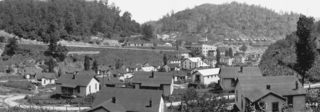 | Back to e-WV
| Back to e-WV
 The West Virginia Encyclopedia
The West Virginia Encyclopedia
 | Back to e-WV
| Back to e-WV
 The West Virginia Encyclopedia
The West Virginia Encyclopedia

Before 1880, much of West Virginia’s rural landscape was made up of dispersed farms and small settlements along valley floors and coves. Country life was simple, quiet, and devoted chiefly to agricultural pursuits. During the decade of the 1880s, however, a transformation in settlement patterns began to take place with the development of industry, particularly coal mining. As railroads penetrated the coal-bearing landscape of West Virginia, mining entrepreneurs leased land, opened mines, and built whole communities. Almost overnight peaceful agricultural valleys changed to energetic company towns.
In coal country, a company town consisted of an agglomeration of dwellings and other buildings situated around the mine. The coal company bought or leased land on which the structures were built, typically including at least a company store, a tipple, dwellings, a church, a school, and a post office. Company towns were not incorporated places, and they had no institutions of government.
In most West Virginia company towns, houses were distributed in an orderly manner reflecting the economic and social hierarchy. The administrators occupied the better houses, either on slopes overlooking the settlement or in the center of the town. Lower-quality housing, often situated on the edge of the community, was occupied by white miners. Blacks and immigrants were located apart, often farther out in less desirable areas near the mine entrances or along hillsides. The mine superintendent usually lived in a mansion having from 10 to 20 rooms and located on a large lot with trees and well-kept grounds. Superintendents sometimes attempted to surpass each other by building larger and more elaborate houses for themselves.
The miners’ houses were much simpler. For economic reasons, there was a tendency toward uniformity in construction of simple three-or four-room dwellings monotonously similar in style. Houses were often painted the same color throughout the town, and some colors were associated with particular companies or towns. Company towns, even substantial ones, were often referred to as ‘‘coal camps.’’
There was a wide range in the quality of West Virginia company towns. Some were better than comparable independent communities, while others were filthy and decrepit. Some were harshly repressive, and others largely free. In West Virginia, company towns existed almost entirely within the coal industry. Timber companies operated rough logging camps of temporary duration and often portable. Cass and a few other large sawmill towns approached the company town model, though they rarely were entirely owned and governed by the mill company.
The life span of the company town usually was 50 to 75 years, or as long as the coal seams were productive. Company towns were especially plentiful in southern West Virginia. In 1930, there were an estimated 465 coal company towns in West Virginia, with the majority in the southern counties of Raleigh, Fayette, McDowell, Logan, and Mingo. There are no company-owned towns today, although remnants of many survive as privately owned communities.
Written by Mack H. Gillenwater
Eller, Ronald D. Miners, Millhands, and Mountaineers. Knoxville: University of Tennessee Press, 1982.
Sullivan, Charles Kenneth. Coal Men and Coal Towns: Development of the Smokeless Coalfields of Southern West Virginia, 1873-1923. New York: Garland Publishing, 1989.
Tams, W. P. The Smokeless Coal Fields of West Virginia. Morgantown: West Virginia University Libraries, 1964.
Gillenwater, Mack H. "Cultural and Historical Geography of Mining Settlements in the Pocahontas Coal Field." Ph.D. diss., University of Tennessee, 1972.